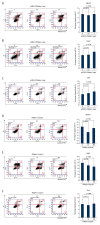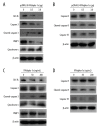Mechanisms of IFNalpha-1a-Induced Apoptosis in a Laryngeal Cancer Cell Line
- PMID: 31542790
- PMCID: PMC6774267
- DOI: 10.12659/MSM.917097
Mechanisms of IFNalpha-1a-Induced Apoptosis in a Laryngeal Cancer Cell Line
Abstract
BACKGROUND Interferon alpha (IFNalpha) exerts its anti-proliferative effect on many human cancers. Among the 13 subtypes of human IFNalpha, IFNalpha-1 subtype has 2 variants, named IFNalpha-1a and IFNalpha-1b, that differ from each other in only 1 amino acid, at residue 114. However, the mechanism by which IFNalpha-1a mediates growth inhibition is still unclear. MATERIAL AND METHODS Human laryngeal carcinoma HEp2 cells were treated with IFNalpha-1a by either transient transfection or exogenous delivery. Western blot and RT-PCR analysis were carried out to assess apoptotic pathways active in IFNalpha-1a-treated HEp2 cells. Microarray analysis was conducted to uncover the differential gene expressions after IFNalpha-1a treatment. KEGG pathway enrichment analysis was also performed. RESULTS IFNalpha-1a markedly inhibited the proliferation and significantly promoted the apoptosis of HEp-2 cells. Mechanistic studies indicate that IFNalpha-1a-mediated cell apoptosis is directly linked to intrinsic and endoplasmic reticulum (ER) stress-related apoptosis, but is independent of extrinsic apoptosis. The top 40 differentially expressed genes discovered by microarray analysis included 20 upregulated genes (e.g., IFI6, IFI27, IFI44L, and MIR548X) and 20 downregulated genes (e.g., PRKDC, HIST1H3B, DYNC1H1, and HIST1H2AM). KEGG pathway enrichment analysis revealed that 4 out of 6 pathways are TP53-related. CONCLUSIONS We demonstrated a detailed mechanism involved in IFNalpha-1a-mediated anti-proliferation activity in human laryngeal carcinoma cells.
Conflict of interest statement
None.
Figures







Similar articles
-
Interferon-α mediates human beta cell HLA class I overexpression, endoplasmic reticulum stress and apoptosis, three hallmarks of early human type 1 diabetes.Diabetologia. 2017 Apr;60(4):656-667. doi: 10.1007/s00125-016-4201-3. Epub 2017 Jan 6. Diabetologia. 2017. PMID: 28062922
-
Inhibition of STAT3 expression by siRNA suppresses growth and induces apoptosis in laryngeal cancer cells.Acta Pharmacol Sin. 2005 Mar;26(3):377-83. doi: 10.1111/j.1745-7254.2005.00053.x. Acta Pharmacol Sin. 2005. PMID: 15715937
-
Alpha-interferon and its effects on signalling pathways within cells.Curr Protein Pept Sci. 2004 Dec;5(6):475-85. doi: 10.2174/1389203043379378. Curr Protein Pept Sci. 2004. PMID: 15581417 Review.
-
Interferon α Induces the Apoptosis of Cervical Cancer HeLa Cells by Activating both the Intrinsic Mitochondrial Pathway and Endoplasmic Reticulum Stress-Induced Pathway.Int J Mol Sci. 2016 Nov 2;17(11):1832. doi: 10.3390/ijms17111832. Int J Mol Sci. 2016. PMID: 27827850 Free PMC article.
-
Alpha-interferon and its effects on signal transduction pathways.J Cell Physiol. 2005 Feb;202(2):323-35. doi: 10.1002/jcp.20137. J Cell Physiol. 2005. PMID: 15389589 Review.
Cited by
-
Protumorigenic Interferon-Stimulated Genes in Cancer: A Comprehensive Review.Cureus. 2024 Jun 26;16(6):e63216. doi: 10.7759/cureus.63216. eCollection 2024 Jun. Cureus. 2024. PMID: 39070493 Free PMC article. Review.
-
Unraveling IFI44L's biofunction in human disease.Front Oncol. 2024 Dec 16;14:1436576. doi: 10.3389/fonc.2024.1436576. eCollection 2024. Front Oncol. 2024. PMID: 39737399 Free PMC article. Review.
-
Identification of IFI27 involvement in the progression of neuroblastoma through bioinformatics analysis and experimental assays.J Mol Histol. 2025 Feb 7;56(2):83. doi: 10.1007/s10735-024-10346-7. J Mol Histol. 2025. PMID: 39915361
-
Impact of Interferon-alpha1b (IFN-α1b) on Antitumor Immune Response: An Interpretation of the Promising Therapeutic Effect of IFN-alpha1b on Melanoma.Med Sci Monit. 2020 Mar 14;26:e922790. doi: 10.12659/MSM.922790. Med Sci Monit. 2020. PMID: 32210221 Free PMC article.
References
-
- Siegel RL, Miller KD, Jemal A. Cancer statistics, 2016. Cancer J Clin. 2016;66:7–30. - PubMed
-
- Kuper H, Boffetta P, Adami HO. Tobacco use and cancer causation: Association by tumour type. J Intern Med. 2002;252:206–24. - PubMed
-
- Boffetta P, Hashibe M. Alcohol and cancer. Lancet Oncol. 2006;7:149–56. - PubMed
-
- Sanchez Barrueco A, Gonzalez Galan F, Lora Pablos D, et al. HPV in larynx squamous cell carcinoma: New serotypes and survival study within 10-year follow-up. Otolaryngol Head Neck Surg. 2017;156:677–82. - PubMed
MeSH terms
Substances
LinkOut - more resources
Full Text Sources
Research Materials
Miscellaneous

